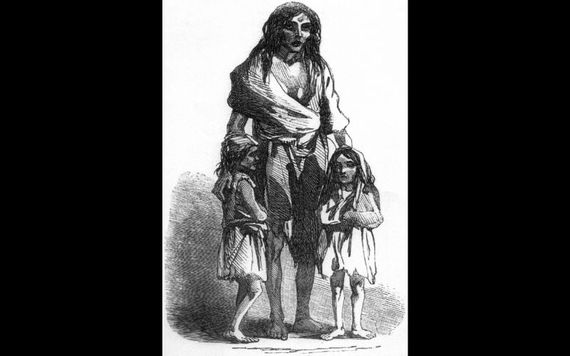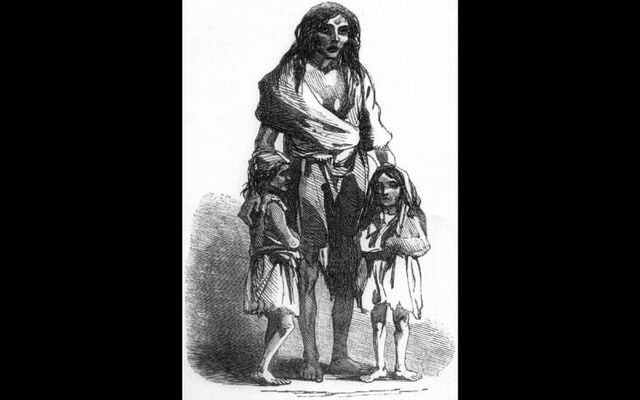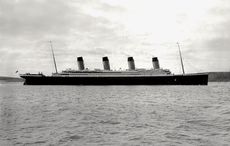The above newspaper illustration is one of the most iconic images from Ireland’s Great Hunger.
Used frequently to accompany books, articles, and exhibitions about An Gorta Mór, the mother and her children have become symbols for the thousands of mothers and children who suffered and perished, struggled, and survived, during Ireland's Famine years of 1845 - 1852.
But the woman is not a mere symbol. She was a real person with a real story – and, as a scholarly essay argues, the subject of what was possibly the first human interest interview in the history of journalism.
Bridget O’Donnel was a poor famine victim from Co Clare whose harrowing story appeared in The Illustrated London News on December 22, 1849.
Evicted from her home while pregnant and sick with fever, O’Donnel endured losing her child at birth and watching her 13-year-old son starve to death. As they suffered from starvation, the corn her family had grown and harvested was carted off to be sold.
Her fate after the interview remains unknown.
Press historians typically date the birth of the journalistic interview as we know it to newspaper pioneer Horace Greeley’s article on Brigham Young, the president of the Mormon Church, in August 1859, with the form becoming popular in the US in the 1860s and in Britain in the 1880s, thanks to the work of William Thomas Stead.
But the following interview with O'Donnel appeared decades earlier in The Illustrated London News:
“I lived,” she said, “on the lands of Gurranenatuoha. My husband held four acres and a half of land, and three acres of bogland; our yearly rent was £7 4s.; we were put out last November; he owed some rent. We got thirty stone of oats from Mr. Marcus Keane, for seed. My husband gave some writing for it: he was paid for it. He paid ten shillings for reaping the corn. As soon as it was stacked, one ‘Blake’ on the farm, who was put to watch it, took it away to his own haggard and kept it there for a fortnight by Dan Sheedey’s orders. They then thrashed it in Frank Lellis’s barn. I was at this time lying in fever. Dan Sheedey and five or six men came to tumble my house; they wanted me to give possession. I said that I would not; I had fever, and was within two months of my down-lying (confinement); they commenced knocking down the house, and had half of it knocked down when two neighbors, women, Nell Spellesley and Kate How, carried me out. I had the priest and doctor to attend me shortly after. Father Meehan anointed me. I was carried into a cabin, and lay there for eight days, when I had the creature (the child) born dead. I lay for three weeks after that. The whole of my family got the fever, and one boy thirteen years old died with want and with hunger while we were lying sick. Dan Sheedey and Blake took the corn into Kilrush, and sold it. I don’t know what they got for it. I had not a bit for my children to eat when they took it from me.”
This illustration of Bridget O'Donnel appeared in The Illustrated London News on December 22, 1849.
Scholar Michael Foley’s 2015 essay “Death in Every Paragraph: Journalism and the Great Irish Famine” explores how the press reported on the famine and how the famine shaped the future of journalism. It is part of the second series of the Famine Folios, a collection of essays that cover various aspects of the Irish Famine by Cork University Press and Ireland’s Great Hunger Museum.
As Foley explains, the interview with O’Donnel was highly unusual for the time: “Newspapers and periodicals did not deal in human-interest stories and did not tell their readers about the poor, except in the most general terms.
"The only way people like Bridget O’Donnel would normally have been named in a newspaper of the day as if she had appeared in court, was before a public hearing or tribunal, was a witness, or was the subject of an inquest.”
O’Donnel was none of these, and the interview – believed to have been conducted by James Mahony, who also drew the sketch of O’Donnel with two of her surviving children – represents a historic milestone for that very reason.
“What was unprecedented about Mrs. O’Donnel was not only that she was named, but that this poor, dispossessed Irish Famine victim was projected onto the international news stage, and her own words were used to convince the world of the massive social and political injustice endured by the people of Ireland,” Foley writes.
In this sense, the Great Hunger forced journalists working in Ireland to re-think the way they approached telling the news. And how could it not have, as “the greatest calamity to hit Europe in the nineteenth century,” leaving one million dead and forcing another three million to emigrate.
Thus, he argues, the Famine actually had a profound impact on the future of journalism. “The changes that were forced upon Ireland by the Famine were eventually beneficial to the development of the press. Despite the declining population, the press developed and grew in the post-Famine period.
"Growing urbanization facilitated distribution, leading to an increase in the number of titles. The growth in the number of English speakers also helped a press that had evolved mainly in the English language.”
You can learn more about the four Famine Folios here.
*Originally published November 2015. Last updated in March 2025.




Comments